Naghsh-e Jahan Square: The Heart of Isfahan, Iran
Naghsh-e Jahan Square, located in the heart of Isfahan, Iran, stands as an extraordinary testament to the grandeur and artistic ingenuity of the Safavid dynasty.
This sprawling urban masterpiece, often referred to as "Image of the World Square," has captivated visitors for centuries with its unparalleled blend of architectural magnificence, historical significance, and cultural vibrancy.
Naghsh-e Jahan Historical Background
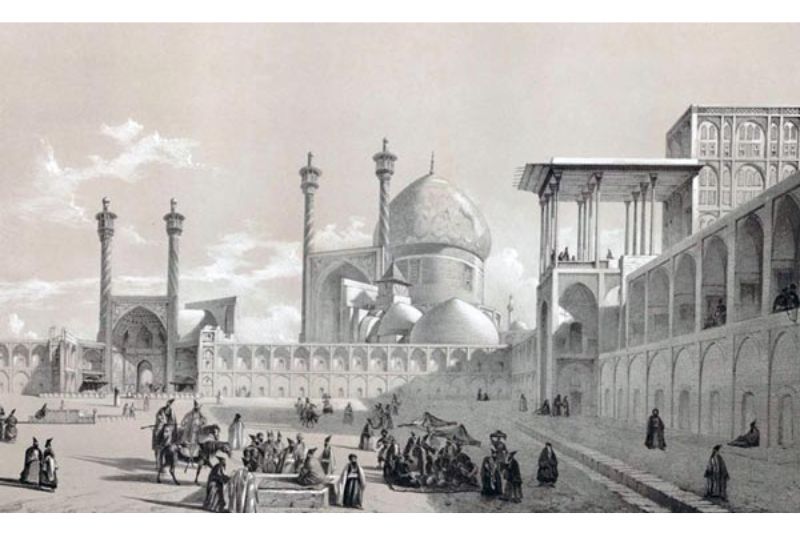
The genesis of Naghsh-e Jahan Square can be traced back to the golden era of the Safavid dynasty, a period marked by cultural flourishing and innovative urban planning. The square's construction began in 1598 under the reign of Shah Abbas I, a visionary monarch renowned for his transformative contributions to Iran's architecture and society.
Recognizing the strategic importance of a central gathering place, Shah Abbas I aimed to create a space that would not only house magnificent structures but also facilitate commerce, cultural exchange, and social interaction. His vision extended beyond architectural beauty; he aimed to unite the diverse facets of his empire through a common space that would be a testament to the glory of Persia.
With the guidance of his talented architects and craftsmen, Shah Abbas I oversaw the construction of Naghsh-e Jahan Square, ensuring that it encapsulated the essence of his reign. The square's completion marked a milestone in Persian architectural history, and it continues to stand as a living tribute to the grand ambitions of its visionary creator.
| Discover: Isfahan Mosques You Should Visit
Layout and Architecture of Naghsh-e Jahan
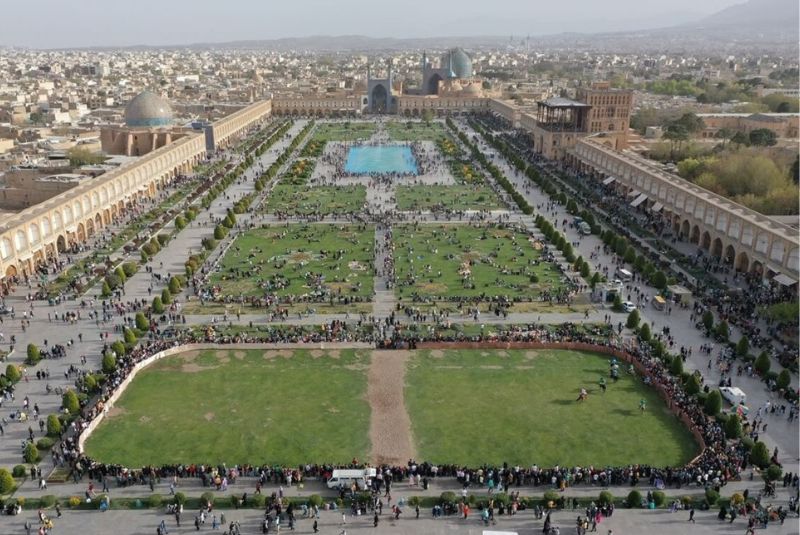
Naghsh-e Jahan Square stretches over an impressive expanse of approximately 160 meters in width and 500 meters in length. Its symmetrical layout and expansive dimensions provide a sense of grandeur that has enthralled visitors for centuries.
Monuments Surrounding the Naghsh-e Jahan
Flanked by impressive structures on all sides, the square's design encourages a harmonious blend of architectural beauty and open space, creating a serene oasis in the midst of the bustling city.
Shah Mosque (Imam Mosque)
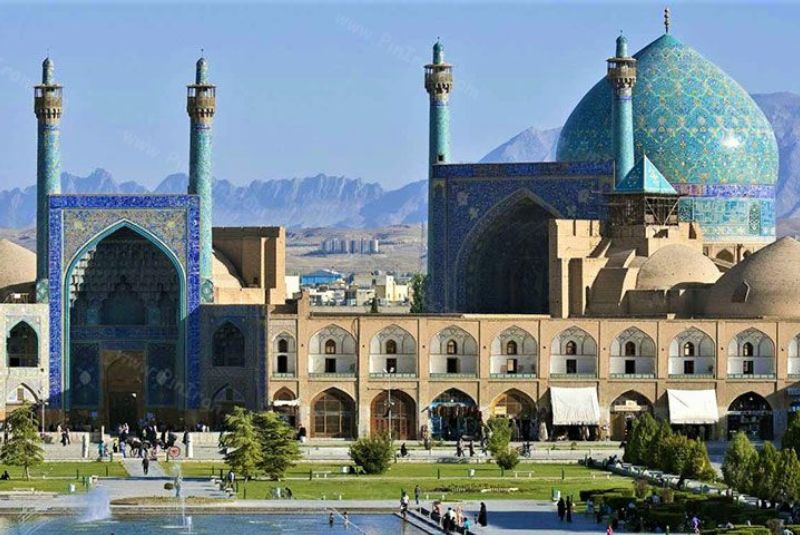
The Shah Mosque, also known as the Imam Mosque, is a masterpiece of Safavid architecture. Its intricate tile mosaic, dazzling calligraphy, and meticulously crafted arches showcase a blend of Persian and Central Asian architectural influences. The main dome is a marvel of engineering and artistry, adorned with intricate patterns that reflect sunlight in mesmerizing ways.
The mosque's construction was a demonstration of Shah Abbas I's devotion to Islam and his desire to establish a place of worship that would symbolize his empire's grandeur. The mosque served not only as a religious center but also as a cultural hub, hosting ceremonies, lectures, and gatherings that enriched the city's intellectual life.
The mosque's façade and interior are adorned with intricate tilework featuring geometric patterns, floral motifs, and verses from the Quran in graceful calligraphy. The vibrant blues, turquoises, and golds of the tiles create a breathtaking visual spectacle that transports visitors to an era of artistic opulence and spiritual reverence.
| Discover: Isfahan Mosques You Should Visit
Sheikh Lotfollah Mosque
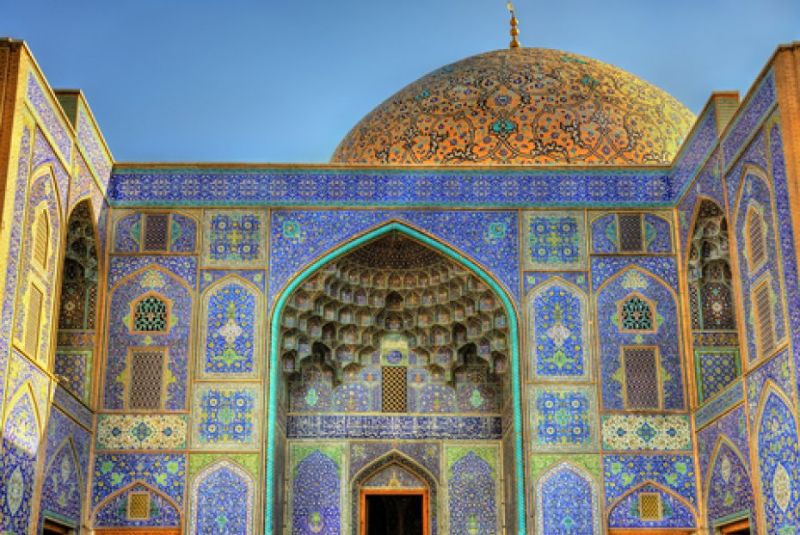
Sheikh Lotfollah Mosque stands as a masterpiece of architectural subtlety. Its distinctive feature includes a hidden entrance that leads to the mosque's main prayer hall, a design choice believed to enhance the sense of privacy and exclusivity. The delicate pink and cream-colored tiles on its exterior add to its elegance.
Unlike the Imam Mosque, Sheikh Lotfollah Mosque was not intended for public congregational prayers. Instead, it served as a private mosque for the royal court and particularly for the women of the Safavid royal family.
The dome's intricate peacock-feather design, realized through a mosaic of tiles, captivates visitors with its intricate beauty. As sunlight filters through the dome's openings, it creates a shifting play of colors on the walls and floors, adding a spiritual dimension to the space.
| Discover: Chehel Sotoun Palace (Isfahan): A Comprehensive Guide
Ali Qapu Palace
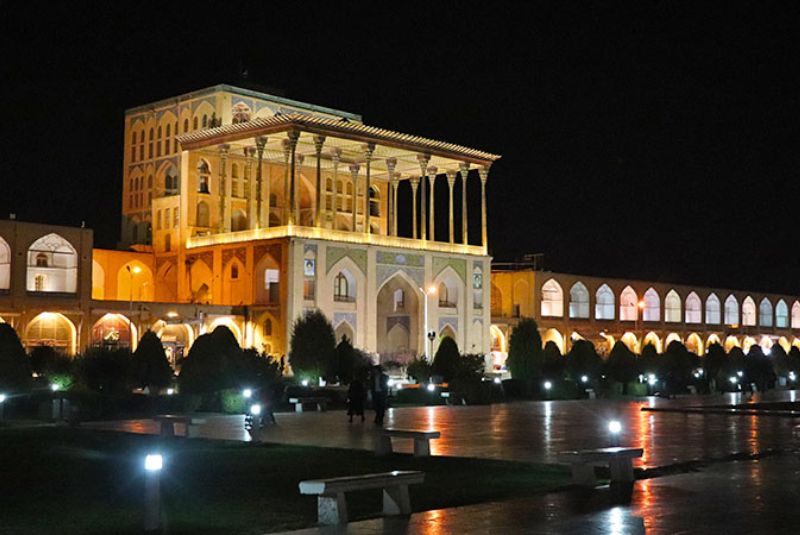
Encompassing both administrative and residential areas, the Ali Qapu Palace served as a multifunctional palace complex. Its architectural grandeur is complemented by its functional importance, as it housed important governmental offices and welcomed foreign dignitaries and ambassadors.
One of the most remarkable features of Ali Qapu is its music room, famed for its acoustic marvels. The intricate stucco decorations lining the walls enhance the room's acoustic properties, allowing a single note to resonate throughout the space in an enchanting manner. Musicians would perform here for the royal court, demonstrating the meticulous attention to detail in its construction.
The palace's upper floors offer a spectacular view of Naghsh-e Jahan Square and the surrounding city. The grand balcony was a place of audience, where Shah Abbas I would address his subjects and foreign diplomats. From this vantage point, the ruler's authority was on full display as he observed the square and the activities below
Qeysarieh Portal and Bazaar
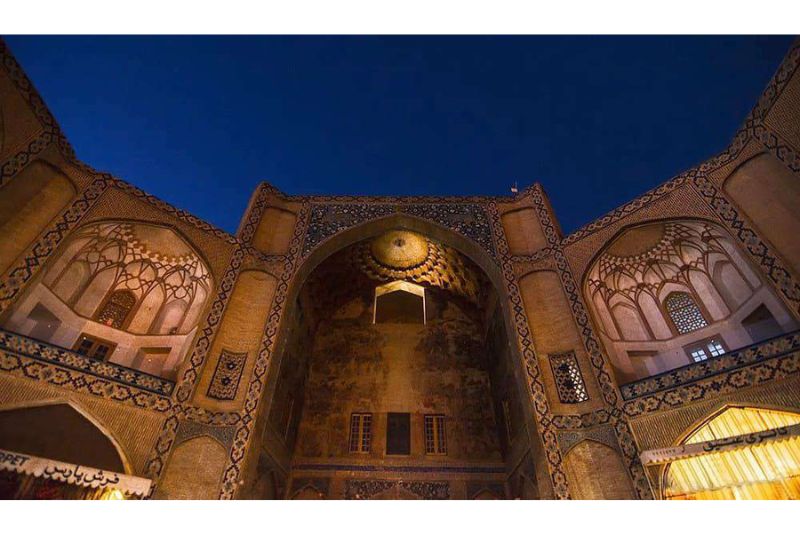
The Qeysarieh Portal in, marking the entrance to the Qeysarieh Bazaar, is a grand gateway that welcomes visitors into a vibrant world of commerce and culture. The bazaar's entrance is an invitation to explore the bustling lanes lined with shops, stalls, and artisans plying their crafts.
The Qeysarieh Portal has historical significance as it served as a conduit for trade and cultural exchange. Caravans laden with goods from distant lands would enter through this portal, enriching the city's markets and connecting Isfahan to a global network of trade.
The Qeysarieh Bazaar continues to thrive as a hub of activity. Visitors can browse an array of goods, including intricate carpets, textiles, spices, ceramics, and other handicrafts. The lively atmosphere, coupled with the aroma of spices and the vibrant colors of the goods, creates a sensory journey through the heart of Isfahan's commercial history.
| Learn About: Persian Garden | A Piece of Paradise in Iran
Cultural Significance of Naghsh-e Jahan Square
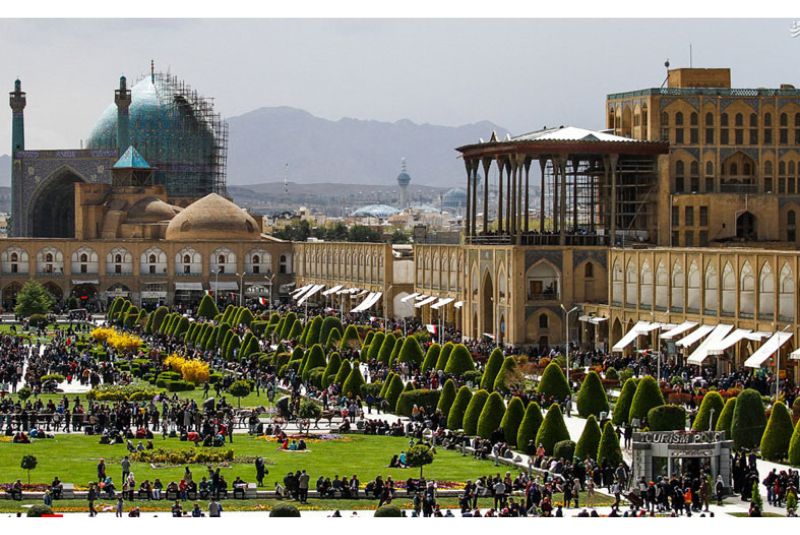
The square stands as an indelible emblem of Isfahan's cultural and historical identity. Beyond its architectural magnificence, the square has played a vital role in shaping the city's character and fostering a sense of community. It has served as a mirror reflecting the city's evolution, from its role in the Safavid dynasty to its present-day position as a UNESCO World Heritage Site.
Throughout the year, the square comes alive with various cultural events and festivals, including:
- Nowruz (Iranian New Year) Celebrations: Naghsh-e Jahan Square becomes a focal point for Nowruz festivities, with elaborate displays, traditional music performances, and joyful gatherings marking the arrival of spring.
- Art and Music Festivals: The square often hosts art exhibitions, live music performances, and cultural festivals that showcase the talents of local and international artists. These events contribute to Isfahan's artistic vibrancy.
- Religious Ceremonies: The square remains a site for religious ceremonies and processions, highlighting its continued significance as a spiritual center within the city.
- Traditional Craft Fairs: Various craft fairs and markets bring together artisans and craftspeople, allowing visitors to explore and purchase traditional Iranian handicrafts and artworks.
- Cultural Lectures and Workshops: Naghsh-e Jahan Square serves as a venue for cultural lectures, workshops, and educational programs that engage both locals and tourists in discussions about history, architecture, and art.
Accessibility and Location of the Naghsh-e Jahan
The square is conveniently situated at the heart of Isfahan, making it easily accessible by various modes of transportation. Whether you're traveling by car, public transport, or even on foot, the square's central location ensures that it's a focal point of the city. Local landmarks and well-known streets often lead to the square, making navigation straightforward for visitors.
Opening Hours and Admission Fees
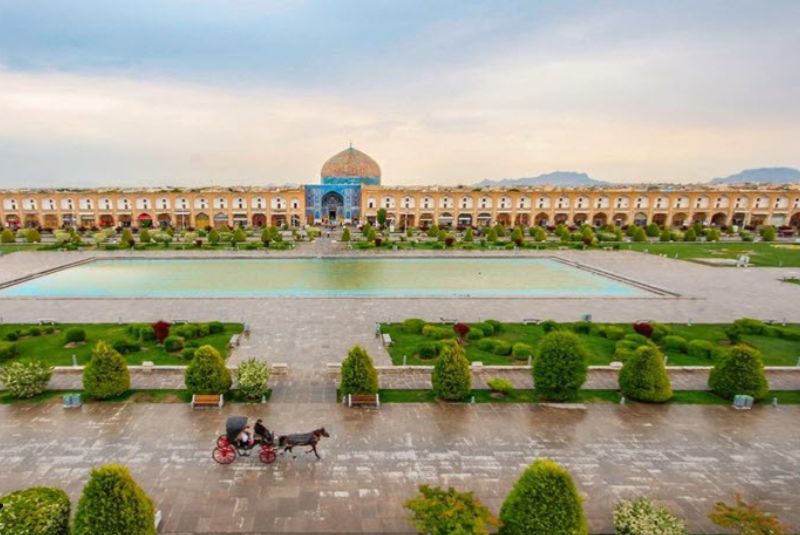
The square is open to visitors year-round, offering different experiences during various times of the day. The best times to explore are early morning and late afternoon when the light accentuates the architectural details.
Entry to the Naghsh-e Jahan Square itself is usually free. However, there may be fees associated with entering specific monuments, such as mosques and palaces. These fees contribute to the preservation and maintenance of these historic sites.
To fully appreciate the historical and architectural significance of Naghsh-e Jahan Square, consider joining a guided tour. Knowledgeable guides can provide valuable insights into the history, culture, and stories behind each monument, enriching your visit.
Tips for Visiting Naghsh-e Jahan Square
- Respect Religious Sites: When entering mosques and other religious sites within the square, remember to act respectfully. Speak in hushed tones, remove your shoes, and dress modestly to show proper reverence.
- Appropriate Dress Codes: In line with Iranian cultural norms, it's recommended to dress modestly when visiting Naghsh-e Jahan Square. Women should cover their hair with a scarf and wear long sleeves and pants or a long skirt. Men should also avoid wearing shorts and sleeveless tops.
- Photography Etiquette: While photography is generally allowed, be mindful of your surroundings and the people around you. Avoid taking photos during prayer times or in sensitive areas where signs prohibit photography.
- Litter and Cleanliness: Help maintain the pristine beauty of the square by disposing of trash responsibly and respecting the environment. Be mindful of your impact on the surroundings.
- Local Customs: Engage with locals and fellow tourists in a friendly and courteous manner. Embrace the opportunity to learn about local customs and traditions.
Notable Landmarks near Naghsh-e Jahan Square
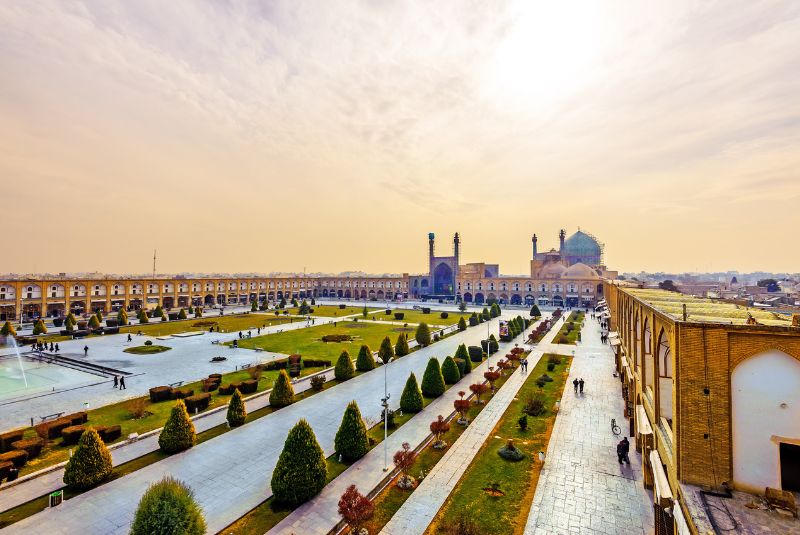
Naghsh-e Jahan Square is surrounded by a treasure trove of historical and cultural landmarks that further enrich your visit to Isfahan. Consider exploring these nearby attractions:
- Chehel Sotoun Palace: Just a short stroll from the square, this palace boasts stunning frescoes, mirrored halls, and lush gardens. The 40 elegantly carved wooden columns in front of the palace give it its name, which translates to "Forty Columns."
- Hasht Behesht Palace: A delightful example of Persian garden pavilions, this palace offers intricate frescoes, delicate stucco work, and beautiful gardens that transport visitors to a bygone era of opulence.
- Jameh Mosque of Isfahan: Known for its architectural diversity spanning centuries, this grand mosque is a UNESCO World Heritage Site. It showcases a unique blend of Islamic architectural styles and is a testament to Iran's rich religious and cultural history.
- Vank Cathedral: A short distance from the square, this Armenian church is a masterpiece of architecture and artistry. Its intricate frescoes depict biblical stories and offer a glimpse into the region's Christian heritage.
- Khaju Bridge: This historic bridge, spanning the Zayandehrud River, is a marvel of engineering and aesthetics. Its design includes pavilions for resting and enjoying panoramic views, making it a popular spot for both locals and visitors.
Walking Routes for Visiting the Surrounding Areas
- Historic Square Circuit: Begin at Naghsh-e Jahan Square and explore the neighboring landmarks, including Chehel Sotoun Palace and Hasht Behesht Palace. This route offers a comprehensive view of Isfahan's architectural heritage.
- Spiritual and Religious Walk: Start at the square and visit the Jameh Mosque of Isfahan and Vank Cathedral. This route offers insights into the city's religious diversity and the architectural styles that have shaped it.
- Riverside Exploration: After visiting Naghsh-e Jahan Square, take a leisurely walk along the Zayandehrud River, crossing the Khaju Bridge. This route provides a serene escape from the urban hustle, allowing you to enjoy the river's tranquility and the bridge's beauty.
- Bazaar and Crafts Trail: From the Qeysarieh Bazaar, explore the bustling market, indulge in traditional snacks, and admire local crafts. This route immerses you in the vibrant culture and commerce of Isfahan.
| Read more: Top 5 Bridges in Isfahan Over Zayanderud River
Naghsh-e Jahan Nearby Restaurants and Cafes
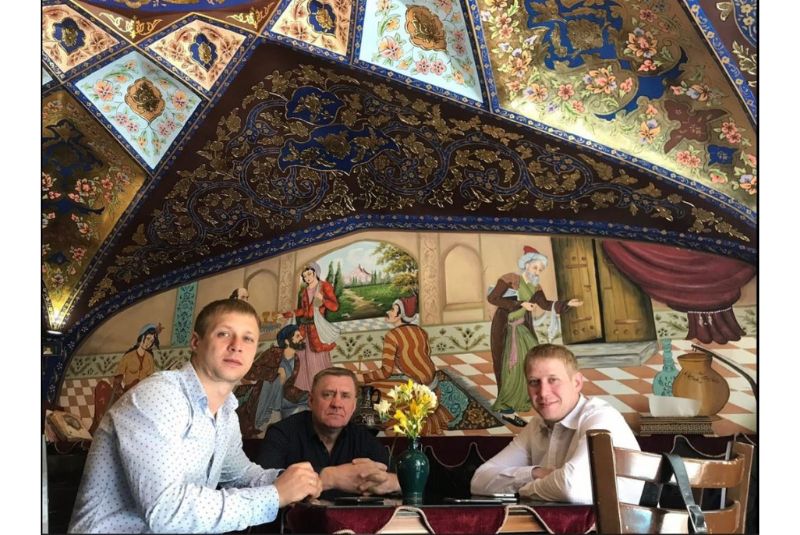
Isfahan is renowned for its exquisite culinary heritage, and experiencing local flavors is an essential part of your visit. Here are some recommendations for restaurants and cafes near Naghsh-e Jahan Square that offer authentic Iranian cuisine:
- Shahrzad Restaurant: Located close to the square, this restaurant offers a wide range of traditional Iranian dishes in an elegant setting. Don't miss the opportunity to try their succulent kebabs and fragrant rice dishes.
- Naghshe Jahan Restaurant: Embrace the taste of Persian hospitality at this restaurant, which serves classic Iranian fare amidst a warm and welcoming ambiance. Their menu includes a variety of stews, grilled meats, and vegetarian options.
- Gol Rezaei Traditional Teahouse: For a more casual experience, visit this teahouse and café. Indulge in a cup of Iranian tea or coffee and savor pastries and snacks while enjoying a traditional setting.
| Related: Best Restaurants in Isfahan
Signature Dishes and Local Specialties to Try
- Chelo Kebab: A quintessential Iranian dish, chelo kebab features succulent pieces of skewered and grilled meat, served with fluffy saffron-infused rice. Variations include beef, lamb, and chicken kebabs.
- Fesenjan: This delectable stew combines chicken or duck with a rich sauce made from pomegranate molasses and ground walnuts. It offers a delightful balance of sweet and savory flavors.
- Zereshk Polo: A colorful and aromatic dish, Zereshk Polo features saffron-infused rice adorned with barberries, creating a visually stunning and tangy-sweet flavor profile.
- Dizi: A hearty and traditional dish, dizi is a slow-cooked stew of lamb, chickpeas, and vegetables, often enjoyed by mashing the ingredients together with flatbread.
- Ghormeh Sabzi: This herb-rich stew is a staple of Iranian cuisine. It features a combination of sautéed herbs, tender chunks of meat (usually beef or lamb), and kidney beans.
- Bademjan: This eggplant-based dish is prepared in various ways, often with sautéed eggplant, tomatoes, and garlic, resulting in a luscious and flavorful spread.
- Baklava and Sweets: Finish your meal with Iranian sweets like baklava, gaz (a nougat-like confection), and saffron-infused ice cream known as Bastani.
Souvenir Shopping in Naghsh-e Jahan
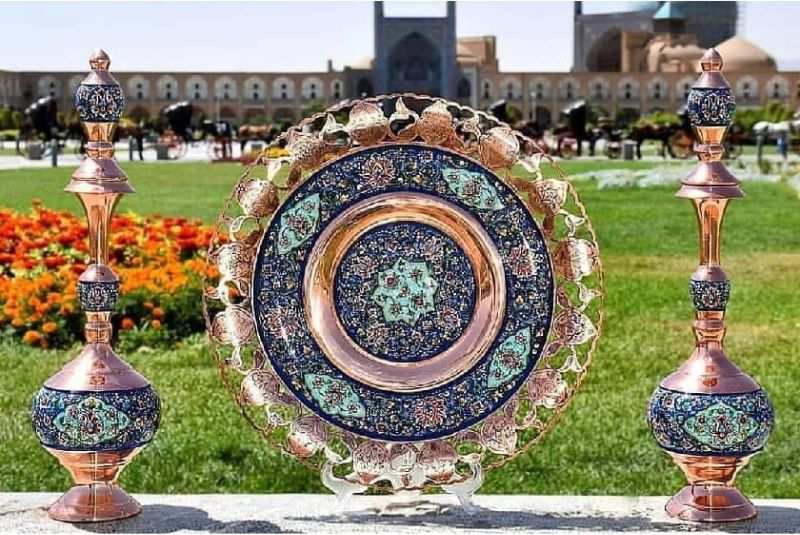
By choosing locally made handicrafts, textiles, and other items, you're not only taking home a piece of Isfahan but also supporting the preservation of traditional craftsmanship. Here are some suggestions for souvenir shopping:
- Persian Carpets and Rugs
- Miniature Paintings
- Enamelware
- Ceramics and Pottery
- Traditional Textiles
- Spices and Saffron
- Handcrafted Jewelry
Naghsh-e Jahan Local Transportation Options
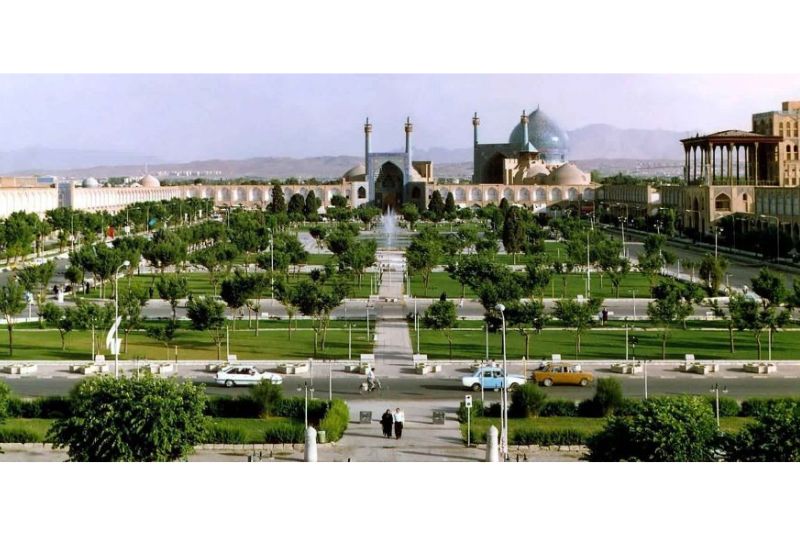
Getting to Naghsh-e Jahan Square is convenient due to its central location in Isfahan. Here are some transportation options:
- Taxi: Taxis are readily available throughout Isfahan. You can easily flag down a taxi or use ride-sharing apps to reach the square. Make sure to negotiate the fare or ask the driver to use the meter before starting the ride.
- Public Transportation: Isfahan has an efficient public transportation system, including buses and metro lines. While buses might require some familiarity with the routes, the metro is a straightforward option to reach various parts of the city.
- Walking: If you're staying in the city center, Naghsh-e Jahan Square and its nearby attractions are often within walking distance. Exploring on foot allows you to soak in the city's ambiance and discover hidden gems along the way.
| Suggestion: Iran Public Transportation Complete Guide
Language and Communication Tips for Travelers

While Persian (Farsi) is the official language of Iran, English is not widely spoken, especially outside of tourist areas. Here are some communication tips to enhance your travel experience:
- Basic Phrases: Learning a few basic Persian phrases can go a long way in interactions with locals. Simple greetings, "thank you," and "please" are always appreciated.
- Translation Apps: Consider using translation apps to bridge the language barrier. Offline dictionaries and translation apps can help you communicate more effectively.
- Body Language: Nonverbal communication can be powerful. A smile, gestures, and respectful body language can often convey your message even when words are limited.
- Writing Addresses: If you plan to visit local shops or attractions, have the address written down in Persian. This will make it easier to communicate with taxi drivers or ask for directions.
- Maps and Pointing: Have maps and navigation apps handy to show directions visually. Pointing on a map or using GPS coordinates can be a helpful way to communicate locations.
Bottom Line
As you step into the expansive embrace of Naghsh-e Jahan Square, you embark on a journey through time and culture. The awe-inspiring architecture, intricate details, and palpable sense of history will transport you to an era of opulence and magnificence.
If you want to go on an exciting trip to Naghsh-e Jahan Square and more, the EavarTravel agency is here to help you discover the amazing things in Iran. We know a lot about making great trips, and we want you to learn about Isfahan's history, culture, and make really special memories.
Share your story!
Comment below and let us know about your Experience.
Your story inspires others!


Comment
Leave a Comment